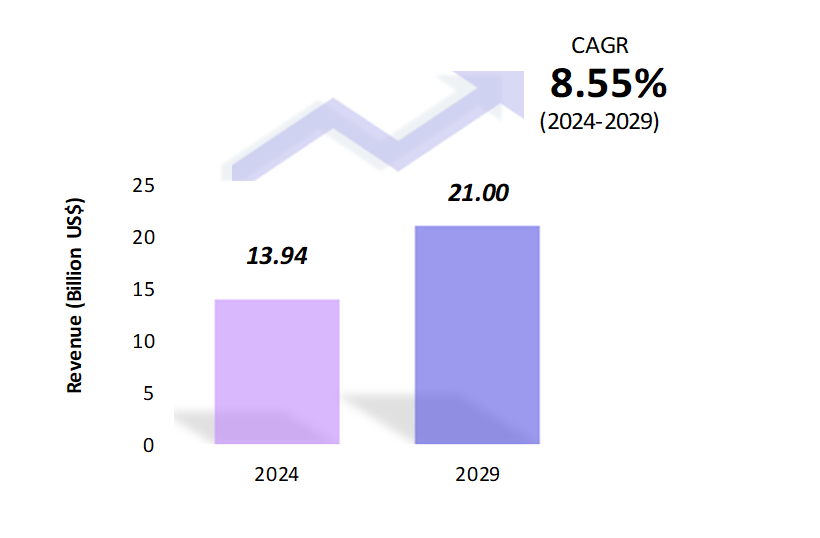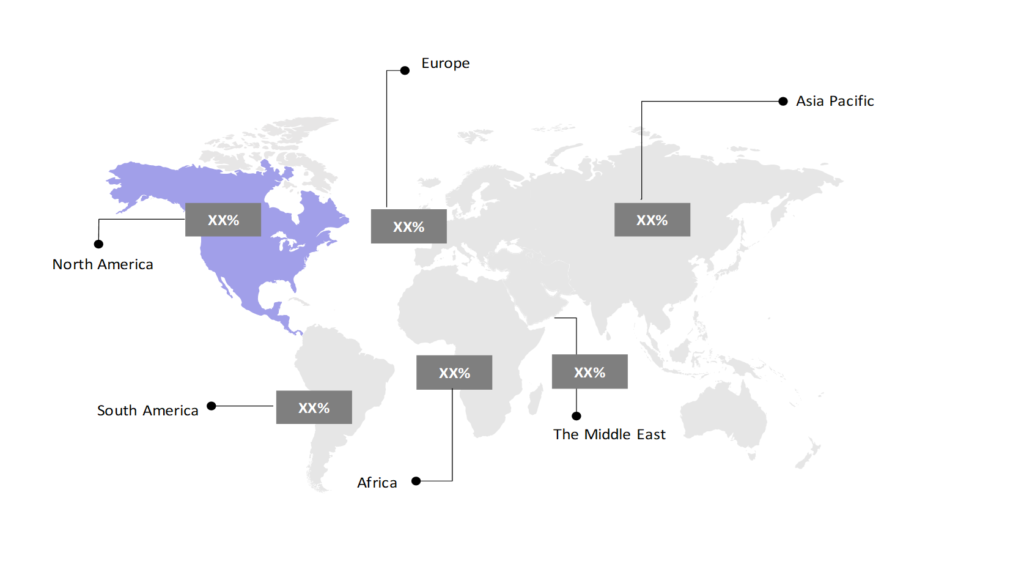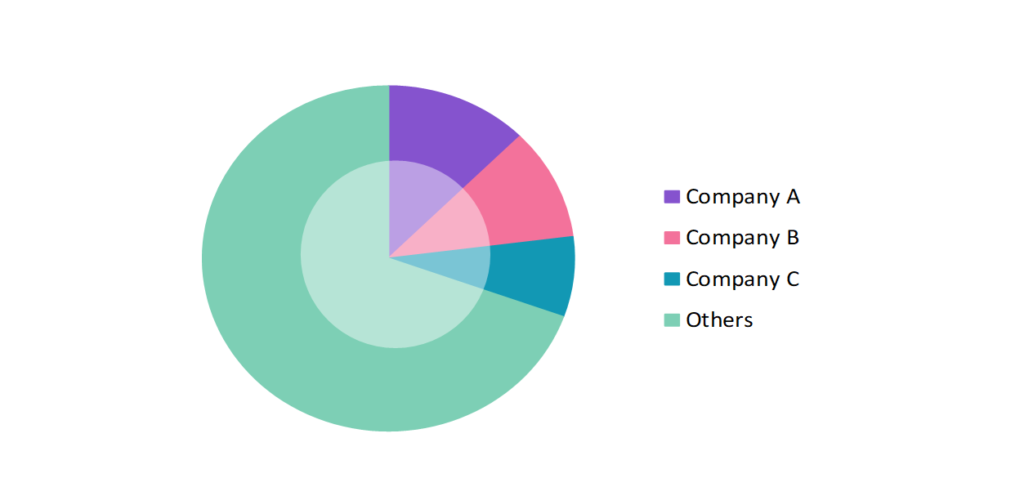Window Sensor Market Insights: Size, Share, Growth Analysis & Forecast (2024-2029)
The report covers a comprehensive analysis segmented by Product Type (Wired Window Sensors, Wireless Window Sensors), by Control System (Fully Automated, Push and Go, Power Assist, Low Energy), by End User (Residential, Commercial, Others), by Geography (North America, South America, Asia Pacific, Europe, the Middle East, Africa).
Window Sensor Market Snapshot

Window Sensor Market Overview
The global window sensor market is estimated to be at $13.94 Bn in 2024 and is anticipated to reach $21 Bn in 2029. The global window sensor market is registering a CAGR of 8.55% during the forecast period 2024-2029.
The Window Sensors Market is a part of the home security and automation industry; it is all about making sure windows and doors are monitored and detected for safety. These sensors are designed to detect unauthorized entry or opening of windows, alerting homeowners or security systems to potential threats. Rising crime rates and a greater understanding of the value of preventative security measures are the main factors driving market expansion. These worries are fueling concerns about home security and safety. Window sensors play a crucial role in comprehensive home security systems, providing an additional layer of protection against intrusions and burglaries.
Technological advancements have been instrumental in driving market expansion, with the development of wireless communication, IoT(Internet of Things) integration, and smart home automation features making window sensors more convenient and effective. Integration with smartphone apps and home automation platforms allows users to monitor and control their window sensors remotely, enhancing convenience and comfort. The market is characterized by intense competition among key players, leading to continuous innovation and product development efforts. Manufacturers are focusing on improving sensor accuracy, reliability, and battery life while reducing costs to remain competitive in the market.
Geographically, North America and Europe dominate the market due to higher awareness levels and greater adoption of smart home technologies. However, emerging economies in Asia Pacific and Latin America are expected to witness significant growth opportunities as disposable incomes rise and urbanization accelerates, driving demand for home security solutions. Overall, the Window Sensors Market is poised for steady growth, driven by increasing security concerns, technological advancements, regulatory requirements, and expanding market reach across different regions.
Window Sensor Market Coverage
| Historical & Forecast Period | 2018-2029 |
| Base Year | 2023 |
| Forecast Period | 2024-2029 |
| Units | Billion US$ |
| Segments | Product Type, Control System, End User |
| Geographies | North America, South America, Asia Pacific, Europe, The Middle East, Africa |
| Key Vendors | Honeywell International Inc., Panasonic Group., Rockwell Automation Inc., Samsung Electronics Co., Ltd., Optex Group Co., Ltd. |
Key Geographies of Window Sensor Market, 2023

Porter’s 5 Forces Analysis of Window Sensor Market

Window Sensor Market Trends
The window sensor market has experienced significant growth in recent years, forced by increasing demand for smart home security solutions and advancements in sensor technology. These sensors play a crucial role in enhancing home security by detecting unauthorized entry through windows and sending alerts to homeowners or security systems. One notable trend in the window sensor market is the integration of advanced features such as wireless connectivity, motion detection, and compatibility with home automation systems. This improves convenience and security by enabling homeowners to integrate their windows into their smart home ecosystems and remotely monitor them.
Another trend is the increasing use of wireless, battery-operated window sensors, which are simple to install and don’t require intricate cabling. As a result, window sensors are now more widely available to a larger variety of customers, offering greater location options and lower installation costs. Moreover, the increasing awareness of home security risks and the growing adoption of smart home devices are directing market growth. Homeowners are increasingly investing in comprehensive security solutions, including window sensors, to protect their properties and loved ones. Furthermore, advancements in sensor technology, such as improved sensitivity and accuracy, are fueling market expansion.
Manufacturers are always producing innovative ideas to create window sensors that are more dependable and effective, providing better detecting capabilities while reducing false alarms. Also, the integration of Artificial Intelligence(AI) technologies has revolutionized the window sensor market, offering advanced capabilities such as threat detection, predictive maintenance, energy management, smart automation, data analytics, and seamless integration with smart building systems. For Example, “Notion” smart home monitoring system. Notion employs AI algorithms to analyze data collected from various sensors, including window sensors, to provide homeowners with valuable insights and alerts. As AI continues to advance, the potential for innovation in the window sensor market is limitless.
The market for window sensors is expected to expand further in the future as consumers look to upgrade their home security systems and incorporate smart technology. But as manufacturer competition heats up, new products are being developed and aggressive price tactics are being used to gain market dominance.
Window Sensor Market Driving Factors
Window Sensors Market highlights several key factors driving its growth. Increasing awareness regarding home security and safety drives demand for window sensors as an essential component of home security systems. With rising incidences of heist and theft, consumers prioritize investing in reliable security solutions thereby, boosting market growth. Additionally, window sensors are made more practical and aesthetically pleasing by technical innovations including the incorporation of wireless connectivity, IoT capabilities, and smart home automation features. For Example, Nest Detect, developed by Nest Labs, a subsidiary of Google, is a multi-functional sensor designed to improve home security and automation. It incorporates wireless connectivity through Wi-Fi and Bluetooth Low Energy (BLE), enabling seamless integration with the user’s home network and other smart devices.
These advancements make it easier for users to monitor and control their home security remotely, further driving market expansion. Moreover, stringent regulations and guidelines about building safety and security standards across residential and commercial sectors contribute to market growth. Additionally, as buildings and towns grow smarter, there is a greater need for products like window sensors, which contribute to building safety, particularly in settings like factories and offices. Increasing disposable income levels, urbanization, and population growth in developing regions stimulate market growth as consumers prioritize investing in home security solutions.
Overall, the Window Sensor Market is driven by increasing awareness of home security, technological advancements, regulatory mandates, the trend of smart cities, and economic factors such as disposable income levels and urbanization. These drivers collectively contribute to the sustained growth and expansion of the market.
Window Sensor Market Challenges
The high initial cost of installing window sensor systems is one of the many factors that need to be taken into account when examining the issues facing the window sensor market. Many consumers, particularly in developing regions or budget-conscious demographics, may find the upfront investment prohibitive, thus limiting market penetration. Additionally, interoperability issues among varied brands and types of window sensors pose a challenge. Lack of standardized communication protocols and compatibility issues with existing security systems can create confusion for consumers and deter them from investing in window sensor solutions. Moreover, concerns regarding privacy and data security present a challenge to market expansion.
With the increasing prevalence of IoT (Internet of Things) and smart home technologies, consumers are becoming more cautious about the potential risks of data breaches and unauthorized access to their personal information through interconnected devices like window sensors. For Example, Verkada, a cloud-based video surveillance service, was hacked in March 2021. Hackers gained access to private information belonging to Verkada’s software clients, including live feeds from over 150,000 cameras installed in various locations such as factories, hospitals, schools, and prisons. The breach occurred through the use of legitimate admin account credentials discovered on the internet.
Furthermore, the complexity of installation and configuration processes for window sensor systems can act as a barrier to adoption, especially for less tech-savvy users. Complicated setup procedures may discourage consumers from investing in these solutions or lead to improper installation, compromising their effectiveness. Additionally, the market faces competition from alternative security solutions such as traditional alarm systems, surveillance cameras, and smart locks. Convincing consumers of the unique benefits and advantages offered by window sensors amidst a crowded security market poses a challenge for manufacturers and vendors.
In summary, challenges including high initial costs, interoperability issues, privacy concerns, installation complexity, and competition from alternative solutions hinder the widespread adoption and growth of the Window Sensors Market.
Window Sensor Market – Key Industry News
- In November 2023, Ikea launched a trio of smart home sensors that are designed to detect opening doors and windows, motion indoors and out, and leaking water.
- In November 2023, Comcast launched a pair of new security products under its Xfinity brand. The new Xfinity Door and Window Sensor and the Xfinity Motion Sensor are designed to be installed, activated, and connected over Wi-Fi.
- In July 2023, Aqara, a provider of smart home products, introduced its new Door and Window Sensor P2, which is built upon the latest Thread protocol. As a new iteration of Aqara’s contact sensor the Door and Window Sensor P2 incorporates Aquara’s advanced automation and security features.
Window Sensor Market Competitive Landscape
The participants in the global window sensor industry are always developing their strategies to preserve a competitive advantage. Companies primarily use acquisitions, R&D, partnerships, and technological launches. Several important entities in the window sensor market include Honeywell International Inc., Panasonic Group., Rockwell Automation Inc., Samsung Electronics Co., Ltd., Optex Group Co., Ltd., and others. Startups and smaller players are also making significant strides in this space by introducing disruptive technologies and cost-effective solutions.
Additionally, tech giants such as Google (Nest) and Amazon (Ring) have entered the market with their ecosystems of smart home devices, further intensifying competition. Innovation is a key differentiator in this market, with companies focusing on enhancing sensor accuracy, battery life, connectivity, and compatibility with existing smart home platforms. Advanced features such as integration with voice assistants, mobile apps for remote monitoring, and AI-powered analytics for predictive maintenance are becoming standard offerings. Market players are also exploring partnerships and collaborations to expand their market reach and enhance product capabilities. For example, collaborations between sensor manufacturers and home security service providers enable seamless integration of window sensors into comprehensive security solutions.
Geographical expansion is another strategy employed by companies to gain a competitive edge. Overall, the window sensor market is characterized by intense competition, driven by technological advancements, innovation, strategic partnerships, and geographical expansion efforts. As the demand for smart home security continues to rise, competition in this market is expected to further intensify.
Window Sensor Market Company Share Analysis, 2023(%)

Window Sensor Market – Key Companies

Reason to Buy from us

Table of Contents
| 1. Introduction |
|---|
| 1.1. Research Methodology |
| 1.2. Scope of the Study |
| 2. Market Overview / Executive Summary |
| 2.1. Global Window Sensor Market (2018 – 2022) |
| 2.2. Global Window Sensor Market (2023 – 2029) |
| 3. Market Segmentation |
| 3.1. Global Window Sensor Market by Product Type |
| 3.1.1. Wired Window Sensors |
| 3.1.2. Wireless Window Sensors |
| 3.2. Global Window Sensor Market by Control System |
| 3.2.1. Fully Automated |
| 3.2.2. Push and Go |
| 3.2.3. Power Assist |
| 3.2.4. Low Energy |
| 3.3. Global Window Sensor Market by End User |
| 3.3.1. Residential |
| 3.3.2. Commercial |
| 3.3.3. Others |
| 4. Regional Segmentation |
| 4.1. North America |
| 4.1.1. The U.S |
| 4.1.2. Canada |
| 4.1.3. Mexico |
| 4.2. South America |
| 4.2.1. Brazil |
| 4.2.2. Argentina |
| 4.2.3. Colombia |
| 4.2.4. Chile |
| 4.2.5. Rest of South America |
| 4.3. Asia Pacific |
| 4.3.1. China |
| 4.3.2. India |
| 4.3.3. Japan |
| 4.3.4. South Korea |
| 4.3.5. Rest of Asia Pacific |
| 4.4. Europe |
| 4.4.1. UK |
| 4.4.2. Germany |
| 4.4.3. Italy |
| 4.4.4. France |
| 4.4.5. Spain |
| 4.4.6. Rest of Europe |
| 4.5. The Middle East |
| 4.5.1. Turkey |
| 4.5.2. UAE |
| 4.5.3. Saudi Arabia |
| 4.5.4. Rest of the Middle East |
| 4.6. Africa |
| 4.6.1. Egypt |
| 4.6.2. South Africa |
| 4.6.3. Rest of Africa |
| 5. Value Chain Analysis of the Global Window Sensor Market |
| 6. Porter Five Forces Analysis |
| 6.1. Threats of New Entrants |
| 6.2. Threats of Substitutes |
| 6.3. Bargaining Power of Buyers |
| 6.4. Bargaining Power of Suppliers |
| 6.5. Competition in the Industry |
| 7. Trends, Drivers and Challenges Analysis |
| 7.1. Market Trends |
| 7.1.1. Market Trend 1 |
| 7.1.2. Market Trend 2 |
| 7.1.3. Market Trend 3 |
| 7.1.4. Market Trend 4 |
| 7.1.5. Market Trend 5 |
| 7.2. Market Drivers |
| 7.2.1. Market Driver 1 |
| 7.2.2. Market Driver 2 |
| 7.2.3. Market Driver 3 |
| 7.2.4. Market Driver 4 |
| 7.2.5. Market Driver 5 |
| 7.3. Market Challenges |
| 7.3.1. Market Challenge 1 |
| 7.3.2. Market Challenge 2 |
| 7.3.3. Market Challenge 3 |
| 7.3.4. Market Challenge 4 |
| 7.3.5. Market Challenge 5 |
| 8. Regulatory Landscape |
| 9. Competitive Landscape |
| 9.1. Honeywell International Inc. |
| 9.2. Panasonic Group. |
| 9.3. Rockwell Automation Inc. |
| 9.4. Samsung Electronics Co., Ltd. |
| 9.5. Optex Group Co., Ltd. |
| 9.6. Company 6 |
| 9.7. Company 7 |
| 9.8. Company 8 |
| 9.9. Company 9 |
| 9.10. Company 10 |
Window Sensor Market – Frequently Asked Questions (FAQs)
What is the current size of the global window sensor market?
The market size for the global window sensor market in 2024 is $13.94 Bn.
Who are the major vendors in the global window sensor market?
The major vendors in the global window sensor market are Honeywell International Inc., Panasonic Group., Rockwell Automation Inc., Samsung Electronics Co., Ltd., Optex Group Co., Ltd.
Which segments are covered under the global window sensor market segments analysis?
This report offers in-depth insights into each product type, control system, end user.
